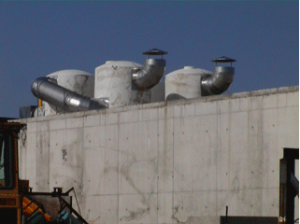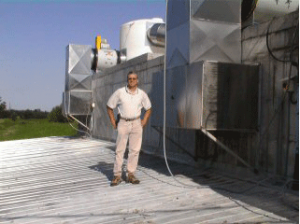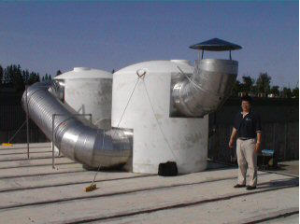Greenwood Mushroom Farm Odor Control System and Results
 Envron co-operated with the Canadian Mushroom Growers Association, the Canadian Federal Government, Provincial Government and Greenwood Mushroom Farm on a full-scale mushroom bunker composting odor control project at Greenwood Mushroom farm. This work was based on earlier work conducted with the British Columbia Ministry of Agriculture that showed positive odor control with Ozone and mushroom compost.
Envron co-operated with the Canadian Mushroom Growers Association, the Canadian Federal Government, Provincial Government and Greenwood Mushroom Farm on a full-scale mushroom bunker composting odor control project at Greenwood Mushroom farm. This work was based on earlier work conducted with the British Columbia Ministry of Agriculture that showed positive odor control with Ozone and mushroom compost.
The installation of the odor control system resulted in the settlement of a $10 million lawsuit launched over the odors from the farm. At this time, Greenwood is expanding the Ozone system to several more bunkers.
The Greenwood odor control equipment is integrated into the composting bunkers using a ventilation system. When compost is present in the bunker, the Ozone system is operated in conjunction with the blowers located in the bunker floor. The ventilation system draws air from the bunker and Ozone is pumped into the exhaust through a mixing/retention system.
The mixing/retention system is designed to provide maximum mixing of the compost exhaust and Ozone so that both gases are thoroughly entrained. The Ozone/exhaust mixture must pass through a three-phase mixing/destruct process.
Results
A study was commissioned by the Canadian Mushroom Growers Association using a consulting firm. When the Ozone system is not engaged, the full composting odor is noticed coming through the stack. When the Ozone system is engaged, the stack has a noticeable Ozone smell which indicates the odors have been eliminated. The report concludes: “Overall, the ozonation system installed at Greenwood Mushroom Farm can control the emission of odour compounds.“
 These results are confirmed in the work done by the University of Britsh Columbia which measured the output from a Surrey, B.C. mushroom composting facility. This system treated gases coming from a composting stack. In this case, a full-blown odor control panel was assembled. There was a residual Ozone smell coming from the destruct stack when tests were conducted. The results of that study with the odor panel showed that the untreated samples required dilution rates of between 1701-3043, which is typical of odorous substances. The Ozone treated samples dilution rates were between 209-264, which is typical of non-odorous substances. As well, the treated samples actually smelled like Ozone which has an almost antiseptic or sanitary smell.
These results are confirmed in the work done by the University of Britsh Columbia which measured the output from a Surrey, B.C. mushroom composting facility. This system treated gases coming from a composting stack. In this case, a full-blown odor control panel was assembled. There was a residual Ozone smell coming from the destruct stack when tests were conducted. The results of that study with the odor panel showed that the untreated samples required dilution rates of between 1701-3043, which is typical of odorous substances. The Ozone treated samples dilution rates were between 209-264, which is typical of non-odorous substances. As well, the treated samples actually smelled like Ozone which has an almost antiseptic or sanitary smell.
 When Envron initially designed the system, the objective was to provide a quantified amount of mixing time at maximum exhaust flow levels and to achieve a residual concentration of Ozone. The residual Ozone concentration indicates that the entrainment of the gases is complete and that not all the Ozone has been used up in the mixing/destruct process. This indicates that the Ozone will continue to react with the exhaust flow and provide further oxidation as the dilution of the gases continues.
When Envron initially designed the system, the objective was to provide a quantified amount of mixing time at maximum exhaust flow levels and to achieve a residual concentration of Ozone. The residual Ozone concentration indicates that the entrainment of the gases is complete and that not all the Ozone has been used up in the mixing/destruct process. This indicates that the Ozone will continue to react with the exhaust flow and provide further oxidation as the dilution of the gases continues.
Composting System Odor Control Study
Allan Finney, Envron Environmental Ltd. designed and installed the mushroom odor control composting system at Greenwood Mushroom Farm in 2003 after an odor panel test on an earlier Envron system conducted with the British Columbia Ministry of Agriculture. The final system report was conducted by G. Duns, Ph.D. A link to the full report is provided here:
Test of Odour Control System using Ozone on aCommercial Scale Mushroom Farm
AAC Project 8519-1 Final Report
January 2004
Administered by:
Ontario Agricultural Commodity Council and Agricultural Adaptation Council
Conclusions of Study
“Overall, the ozonation system installed at Greenwood Mushroom Farm can control the emission of odour compounds. Chemical analysis of samples of mushroom substrate gases taken before and after contact with ozone indicated that levels of odorous sulfur compounds were reduced in the range 20-60% by the ozonation. The extent of this reduction appears dependent on the operating conditions of the bunker.
Operation of the aeration fan, for example, tends to increase the volume of gases and odorous compounds entering the treatment system, thereby lowering the efficacy of the treatment system. Increasing the amount of ozone entering the treatment system in certain cases appears to increase the extent of reduction of reduced sulfur compounds. Further research should be undertaken to enhance understanding of this ozonation odour control system and to optimize operational conditions to increase overall reduction of odorous compounds from the compost emissions.T
he present study has utilized chemical analysis to test the efficacy of ozonation as a viable means of odour control. The ultimate evaluation of any system for controlling or reducing odours is performed using a combination of chemical analysis and organoleptic or odour panel assessments of the odours (Dorling, 1977; Duns et al., 2003). Relating results from chemical analysis to odour panel measurements converted to odour units is ideally the most informative way to quantitatively relate constituent odour target compounds to human assessment of odours…..”
G. Duns, Ph.D.
AirChem Consulting and Research Inc.
3268 Stonebrook Rd.Bright’s Grove, Ontario NON 1C0
Project Co-Ordinator:
William Stevens Ph.D.
Canadian Mushroom Growers Association
7666 Mill Rd.
Guelph, Ontario NiH 6J1
Tel. (519) 829-4125 Fax (519) 837-0729
Funded by:
Agriculture and Agri-Food Canada
& Ontario Ministry of Agriculture and Food
